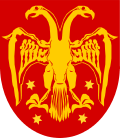Đurađ Đurašević
| Đurađ Đurašević Crnojević | |
|---|---|
| voivode | |
| Coat of arms |
 |
|
Issue | |
| Noble family | Crnojević |
| Father | Radič Crnojević |
| Mother | Jelena |
| Born | mid-14th century[1] |
| Died | after 1435[1] |
| Buried | Kom Monastery |
Đurađ Đurašević Crnojević (Serbian: Ђурађ Ђурашевић Црнојевић, fl. 1413–1435) was the lord of Paštrovići (a coastal tribe) of the Lordship of Zeta and a voivode of the Serbian Despotate, alongside his younger brother Aleksa (Lješ).
Đurađ and his brother Aleksa (Lješ) were lords of the territory of Paštrovići (Luštica and hills above Kotor and Budva) during the reign of Balša III.[2] The Đurašević family was a branch of the Kalođurđević family.[3] Its members held the most distinct positions in the court of Balša III.[4] Đurađ was the head of the family.[5] Đurađ was one of the witnesses listed in the charter issued by Balša III when he founded a church of the Praskvica Monastery in 1413. Đurađ's son and Aleksa Paštrović, an envoy of Sandalj Hranić, were also present.[6] Đurašević was elected as a witness and maybe the executor of the charter of Balša III because at that time he ruled over Paštrovići, Luštica and the hills above Kotor and Budva.[7]
After the death of Balša III they refused Venetian invitations to switch sides and to accept Venetian suzerainty remaining loyal to new lord of Zeta, Serbian Despot Stefan Lazarević.[8] They controlled 10 salt ponds in Grbalj valley near Kotor.[9] Đurađ and his brother Aleksa built the Kom Monastery in the period between 1415 and 1427, when Upper Zeta was held by the Crnojevići.[10]
On 10 March 1420 Venetians promised to appoint Đurađ and his brother Aleksa (Lješ) as governors of Budva.[11]
Đurađ Đurašević was a member of the Crnojević noble family. He had four sons: Đurašin Đurašević, Gojčin Crnojević, Stefan (Stefanica) Crnojević and fourth son with unknown name and historical role.[12]
| Ancestors of Đurađ Đurašević | |||||||||||||||||||||||||||||||||||||||||||||||||||||||||||||||||||||||||||||||||||||||||||||||||||||||||||||||||||||||||||||||||||||||||||||||||||||||||||||||||
|---|---|---|---|---|---|---|---|---|---|---|---|---|---|---|---|---|---|---|---|---|---|---|---|---|---|---|---|---|---|---|---|---|---|---|---|---|---|---|---|---|---|---|---|---|---|---|---|---|---|---|---|---|---|---|---|---|---|---|---|---|---|---|---|---|---|---|---|---|---|---|---|---|---|---|---|---|---|---|---|---|---|---|---|---|---|---|---|---|---|---|---|---|---|---|---|---|---|---|---|---|---|---|---|---|---|---|---|---|---|---|---|---|---|---|---|---|---|---|---|---|---|---|---|---|---|---|---|---|---|---|---|---|---|---|---|---|---|---|---|---|---|---|---|---|---|---|---|---|---|---|---|---|---|---|---|---|---|---|---|---|---|
| |||||||||||||||||||||||||||||||||||||||||||||||||||||||||||||||||||||||||||||||||||||||||||||||||||||||||||||||||||||||||||||||||||||||||||||||||||||||||||||||||
References
- 1 2 Popov, Čedomir (2009), Srpski biografski rečnik (PDF) (in Serbian), Novi Sad: Budućnost, p. 65, ISBN 9788679460370, OCLC 690445723,
Ђурађ Ђурашевић/Црнојевић, властелин, војвода (?, средина ХIV в. — Зета, после. 1435)
- ↑ Milivoje Pajović (2001). Vladari srpskih zemalja. Gramatik. p. 130.
Тако су и браћа Ђурађ Ђурашевић Црнојевић и Љеш Алекса Ђурашевић Црнојевић у време Балше III Балшића, управљали Паштровићима, Луштицом и брдским крајевима изнад Котора и Будве.
- ↑ Ivan Božić (1979). Nemirno Pomorje XV veka. Srpska književna zadruga. p. 132. Retrieved 11 January 2014.
Породица Ђурашевић из Паштровића припадала је Кало- ђурђевићима
- ↑ Fine 1994, pp. 512-513
- ↑ Fine 1994, pp. 521
... Djurasevici, under the family head George (Djuradj),...
- ↑ Istorijski časopis. Institut. 1960. p. 156. Retrieved 13 June 2013.
- ↑ Blagojević, Miloš (2001). Državna uprava u srpskim srednjovekovnim zemljama (in Serbian). Službeni list SRJ. p. 166.
Избор Ђурђа Ђурашевића за милосника није био случајан. У доба издавања већ поменуте повеље којом се оснива манастир Св. Николе у Прасквици, војвода Ђурађ Ђурашевић управљао је „Паштровићима, Луштицом и ...
- ↑ Bešić 1970, p. 135
Примамљивим млетачким позивима нису се одазвали ниЂурашевићи нити су помишљали да заузму одметнички став свогпретходника Радича Црнојевића. Поред Ђурђа, и Љеш је постао„деспота Степана воевода
- ↑ Bešić 1970, p. 146
Од 143 сона поља которска је општина располагала еамо са 32, док су остала припадала Балши (34), зетском митрополиту (24), Луштичанима (27), Ђурашевићима (10),
- ↑ Dimitrije M. Kalezić (2002). I - O. Savremena administracija. p. 1010. Retrieved 23 April 2013.
КОМ, манастир са храмом посвећеним Успењу Прес- вете Богородице подигнутје између 1415. и 1427. год. на источним падинама острва Одринска гора, западно од Жабљака Црнојевића, као задужбина Ђурђа и Љеша Црнојевића, који се у историјским изворима иомињу између 1403. и 1435.
- ↑ Lazo M. Kostić (1961). O srpskom karakteru Boke Kotorske. Izdan'e piščevo. p. 30.
Дал>е пише Мадираца: «Дана 10 марта 1420, Венещца обећа Будву ЂорЬу и ЛЬешу Ђурашевићу, зетским баронима
- ↑ Bešić 1970, p. 190
Sources
- Fine, John Van Antwerp (1994). The Late Medieval Balkans: A Critical Survey from the Late Twelfth Century to the Ottoman Conquest. University of Michigan Press. ISBN 978-0-472-08260-5.
- Bešić, Zarij M. (1970). Istorija Crne Gore / 2. Crna gora u doba oblasnih gospodara. (in Serbian). Titograd: Redakcija za istoiju Crne Gore. OCLC 175122851.